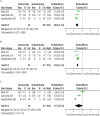The association between disordered eating and health-related quality of life among children and adolescents: A systematic review of population-based studies
- PMID: 31584956
- PMCID: PMC6777752
- DOI: 10.1371/journal.pone.0222777
The association between disordered eating and health-related quality of life among children and adolescents: A systematic review of population-based studies
Abstract
Background: Previous studies have documented that disordered eating is associated with a wide range of impaired physical and mental health conditions among children and adolescents. The relationship between disordered eating and health-related quality of life (HRQOL) has been predominantly examined in children and adolescents who are overweight or obese or suffer from chronic illnesses. In the last decade, several studies have been conducted to investigate the relationship between disordered eating and HRQOL among school and community children and adolescents. No systematic review or meta-analysis has synthesized the findings from these population-based studies. The purpose of this systematic review and meta-analysis was to synthesize the relationship between disordered eating and HRQOL among the general population of children and adolescents.
Methods: We performed a computer search for the English language literature using the databases PUBMED, EMBASE and PSYCINFO to retrieve eligible studies published between 1946 and August 9, 2018. We also searched the relevant articles using PubMed related article search features and manually examined the reference lists of the retrieved full text articles selected from the database search. The association between disordered eating and HRQOL was synthesized using both a qualitative method and a meta-analysis. The review was conducted adhering to the Preferred Reporting Items for Systematic reviews and Meta-Analyses (PRISMA) guidelines.
Results: We identified eight studies that met the inclusion criteria and were included in the final synthesis. The studies included six cross-sectional studies and two longitudinal studies. The systematic review found that disordered eating attitudes and behaviors were associated with lower HRQOL among children and adolescents. Children and adolescents with bulimia nervosa (BN), binge eating disorder (BED), purging disorder (PD) and other eating disorder symptoms had poorer HRQOL than their healthy peers without the eating disorder conditions. The meta-analysis using four out of the eight studies showed that disordered eating was significantly associated with poor psychosocial health and lower overall HRQOL among children and adolescents.
Conclusion: The present review reveals that disordered eating behaviors and eating disorders are associated with decreased HRQOL in children and adolescents. More prospective studies are needed to ascertain the directions in the relationship between disordered eating and HRQOL among children and adolescents. The findings of this review suggest that health programs for promoting healthy eating and reducing disordered eating behaviors among school children and adolescents may help to enhance the HRQOL and overall health status of these individuals.
Conflict of interest statement
The authors have declared that no competing interests exist.
Figures


References
-
- Association, American Psychiatric, 2013. Diagnostic and Statistical Manual of Mental Disorders: DSM-5. American Psychiatric Publishing, Washington, DC.
Publication types
MeSH terms
LinkOut - more resources
Full Text Sources
Medical
Miscellaneous

